Pooja K. Agarwal's Blog
November 7, 2025
Do your students use concept maps? They might be missing this key link

If you and your students use concept mapping as a class activity or study strategy, there might be something missing. Based on research by educator and scientist Dr. Kripa Sundar, the key to an effective concept map isn’t the “node” or the key concept inside a bubble. It’s the “link,” or the relationship between concepts, that counts. Learn how to make the most of concept maps with these simple research-based tips and resources.
And continue reading for FREE stuff:
Are you going to the Learning & the Brain Conference in Boston next week? I’m hosting a book giveaway!
Do you like audiobooks? Smart Teaching is now available on Audible for free! (with a membership or free trial)
Are you reading Smart Teaching for a professional learning community? I’m hosting free Zooms!
Buy Smart Teaching Stronger Learning How to get a free book, audiobook, and Zoom
Free book giveaway and signing: On Saturday, November 15 from 12:00 – 2:00pm, join me in Boston at the Learning & the Brain Conference in the Westin Hotel lobby. Bring a copy of my new book Smart Teaching with you to receive a free copy of my first book Powerful Teaching (only 25 available). Both books are available for purchase online and at the conference bookstore. I’ll have a few copies for sale in person with me, as well. (Make sure you keep an eye out for these two red flags at education conferences.)
Free audiobook: Smart Teaching is now available as an audiobook, included with an Audible membership or a free trial. A big thank you to teachers from the Morton School District in Washington state for their enthusiastic nudges to make this happen. I used AI for the voice narration, and I have many mixed feelings about it. Click here to listen to a comparison of the AI voice for Smart Teaching vs. a human narrator for Powerful Teaching. Which one do you prefer? I’m genuinely curious. Reply to this email and let me know.
Free Zooms: I host free Zooms for schools and universities who have purchased 50 or more copies of Smart Teaching for their professional learning community, book clubs, and course adoptions. If this sounds like you, or if you’re interested in a bulk discount, please contact me at ask@retrievalpractice.org.
And here are even more free resources:
Sign up for Ditch Summit, a free online conference starting in December. Some of my favorite college teaching activities are from Ditch Summit, so even though it’s geared toward K–12, I encourage all educators to sign up. My colleague Dr. Janell Blunt (with her popular whiteboard strategy) will be a featured speaker.
Download my Padlet instructions for students on how to post and comment with videos. In my transition from Flip to Padlet, my students were struggling with how to get things to show up. Feel free to copy, download, change, and use my slide deck.
Get the new audiobook The key to concept maps? Linking words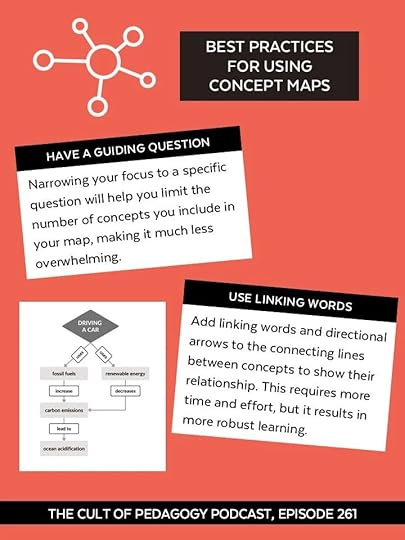
As cognitive scientist and educator Dr. Kripa Sundar explains in our book Smart Teaching Stronger Learning:
“What differentiates an effective concept map from other graphic organizers, or even a paragraph or list of responses? Teachers and learners typically focus on big concepts and nodes during learning, but often expertise comes from seeing how concepts are connected with linking words.”
In a recent podcast episode with Cult of Pedagogy, Dr. Sundar shares examples and research on how linking words are the key to effective concept maps. For example, imagine two concept maps that identify the relationship between apples and pie. One student might use the linking words “taste best in” to connect apples with pie, whereas another student might use the linking words “are a filling in” to connect apples with pie.

Which of these linking words is more effective for learning, taste or filling?
The more specific, the better. Often, students create a concept map with linking words that describe a general relationship rather than a specific connection. The absence of students’ linking words can highlight possible confusion or gaps in understanding, as well. A student’s response depends on context and prior knowledge, as well as the guiding question being asked.
Dr. Sundar’s key tip: When your students are concept mapping, make sure they explicitly label the relationship between the two concepts they are connecting. Concept mapping can be as easy as apple pie, but make sure you include the links.
Listen on Cult of Pedagogy Follow Dr. Sundar on LinkedIn Learn about Dr. Kripa Sundar
Dr. Kripa Sundar (NarayanKripa Sundararajan, she/her) is the Founder and Lead Consultant at EdTech Recharge in Irvine, California. Her boutique impact research and consulting firm supports mission-driven education leaders to execute evidence-based product strategy toward implementation and measurement at scale, including global companies across the United States, United Kingdom, Canada, Spain, Australia, and India. She earned her Ph.D. from Washington State University.
Dr. Sundar is also an adjunct professor and the author of a book for children and their caregivers, entitled How Do I Learn. She has featured articles in Edutopia and in the American Educator.
Additional resources from Dr. Sundar:
Another interview with Cult of Pedagogy on how to read academic research
A YouTube video series for teachers with even more tips
A practice guide on meta-analyses and what Hattie’s “scores” really mean

Recommended publications by Dr. Sundar:
Sundararajan, N. K., Adesope, O., & Cavagnetto, A. (2018). The process of collaborative concept mapping in kindergarten and the effect on critical thinking skills. Journal of STEM Education, 19(1), 5–13.
Sundararajan, N., & Adesope, O. (2020). Keep it coherent: A meta-analysis of the seductive details effect. Educational Psychology Review, 32(3), 707-734.
Wang, Z., Adesope, O., Sundararajan, N., & Buckley, P. (2021). Effects of different concept map activities on chemistry learning. Educational Psychology, 41(2), 245-260.
Read Dr. Sundar's ResearchOctober 20, 2025
Include an "ask me anything" in your class to boost learning and community
One of my favorite activities when I teach is an “ask me anything” session (AMA). Students ask me questions about content, of course, but a structured AMA is a fantastic opportunity to boost learning and build class community. Importantly, AMAs are not Q&As. With no-tech and low-tech options for all grade levels and class sizes, continue reading for my tips on how to facilitate an AMA during your class.
I recently held a free AMA on Zoom, exclusively for my newsletter subscribers. Make sure to sign up at retrievalpractice.org/subscribe to receive announcements about future events. I also offer virtual and in-person AMAs, keynotes, and workshops with teachers and students around the world. Email me at ask@retrievalpractice.org or complete this Google Form to receive more information.

an AMA with a book club at Tufts University
Request an AMA at your school Learn more about me and ask me anything!

Whether you’re a new subscriber or long-time follower of RetrievalPractice.org, I thought it’s time I (re)introduce myself.
I’m Dr. Pooja Agarwal (she/her, @RetrieveLearn), and I love making teaching and learning memorable. I’m a cognitive scientist, teacher, book author, and speaker. I’ve published 2 books, 20+ academic journal articles, visited hundreds of schools, and taught thousands of students. I’m also an Associate Professor of Psychology at the Berklee College of Music in Boston, where I teach psychology and neuroscience to exceptional musicians.
In addition to my teaching and research, I’m an advocate for diversifying the field of cognitive science and I create free, open access resources for teachers about the science of learning.
Over the 10 years I’ve been sending my newsletter (wow) and the 20 years I’ve been teaching and conducting research (wowza), I’ve received thousands of questions from educators around the world. I teach nearly 90 college students each semester (for those in higher ed, I have a 4/4 course load) and I wish I had more time to write about each question I receive. That’s why I love visiting schools virtually and in person. I love fielding unexpected questions and facilitating thought-provoking discussion on the fly. I always get asked at least one question that stumps me or gives me a new idea to chew on, too.
Some fun facts about me:
For my birthday last week (thank you all for your well wishes), my partner and I went to an agricultural fair. I held a baby chick! I don’t think I’ve done that since I was in 2nd grade (photos above). I was born and raised in Illinois, and I have a lot of nostalgia for local fairs.
My favorite country is Uruguay, my favorite musical artist is Michael Jackson, my favorite book is The Giver, and my favorite movie is the Princess Bride.
I enjoy cooking, tango dancing, and binge watching Netflix. Most recently, I finished watching Monster: The Ed Gein Story. It’s a bit gruesome, but if you like true crime, I’d recommend it.
I hope to see you during my AMA on Zoom or at a future event. Feel free to ask me anything!
Follow me @RetrieveLearn Download my research Learn more about my books How to incorporate AMAs in your classes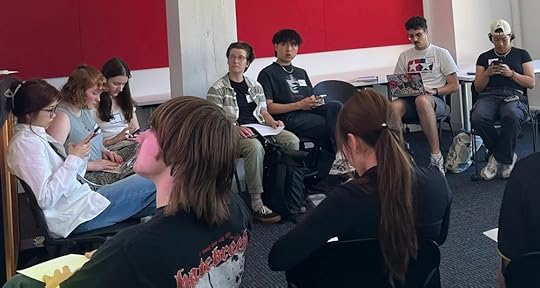
My students using Slido for an AMA during class
When I asked my students for mid-semester feedback, I was surprised that they wanted me to include more time for “ask me anything” (AMA, a type of interview format that’s popular on the website Reddit). I have an AMA during the first week of class, but I didn’t realize how much my students enjoy it. Of course, students ask questions during lessons, but I find that an open-ended AMA is an effective way to encourage retrieval practice about course topics, while also fostering engagement and community. I also include an AMA during my professional development keynotes and workshops. I never know what questions I’m going to get, but that’s part of the fun for me, too.
An important distinction: AMAs are not Q&As (question and answer sessions, which are typically about course content). Because I frame the activity as “ask me anything,” my college students feel more comfortable asking clarifying questions about specific course topics and asking about psychology, my career, and my thoughts on the world. I find that my students are respectful in the questions they ask and they understand if there’s a question I choose not to answer. Plus, unlike Q&As, AMAs are anonymous, so students don’t have to raise their hand to ask a question in front of the entire class.
Whether you teach K–12 students, college students, or graduate students, here are my tips for how to incorporate an AMA in your classroom:
Regarding timing, you could answer all the questions at once or answer a few during each class meeting. To calculate the amount of time you need for an AMA, I recommend allowing for 30–60 seconds per question. For example, I answer approximately 20 questions in 15 minutes.
For a no-tech AMA, use index cards: Hand out index cards, have students anonymously write down questions, collect and shuffle the cards, and go through students’ questions. You can invite all students to complete an index card, which provides a nice variety of questions, and you can moderate or rephrase questions if needed. For added retrieval practice, have students retrieve two things on one side of the index card, with their AMA question on the other side.
For an AMA using ed tech apps like Slido or PollEverywhere, you embed a slide into Google Slides or Powerpoint, and students scan a QR code to type in their question anonymously on a website.
In the photo above, my class is using an ed tech app called Slido. I use the free version, which includes the Q&A feature and 3 polls, like open text, a word cloud, and multiple-choice questions. Slido integrates well with Google Slides and it takes literally 10 seconds to add an anonymous Q&A into my slides. One feature I like about Slido is that you can “highlight” or display each individual question full-screen on the projector, increasing accessibility for all students. Slido also has an “upvote” option, which I encourage students to use so that we can prioritize the most popular questions during the AMA. Click here for more ed tech polling tips from the fantastic podcast/blog Teaching in Higher Ed.
Recently, I joined college students at Claremont McKenna College for an AMA via Zoom, in a psychology class taught by my colleague and cognitive scientist Dr. Sharda Umanath. Students asked insightful questions about how to study effectively, how to conduct research in schools, and how to use retrieval practice for lifelong learning. I love speaking with students of all ages, so if you’re interested in hosting an AMA for your school or class, please don’t hesitate to contact me. If you’re in K–12, you should also check out the free resource Skype a Scientist to connect with more scientists around the world.

An AMA with college students at Claremont McKenna College
Here are some questions students asked during the AMAs, which were a lot of fun to ponder:
What are your favorite and least favorite things in psychology?
Who’s your favorite musical artist?
Do you have any advice on how to cope with procrastination?
What is the most random fact you can think of right now?
And here are some questions I discussed during my recent free AMA on Zoom for newsletter subscribers:
How do you approach generative AI in your classroom?
How do you motivate students if retrieval practice is ungraded?
What are your favorite strategies from your books Powerful Teaching and Smart Teaching Stronger Learning?
How do you balance covering course content while also providing time for retrieval practice?
How did you get interested in the science of learning?
What is a finding from your research that surprised you?
What is your favorite “hidden gem” attraction or restaurant in Boston?
Explore more class activitiesOctober 16, 2025
The most common question I get asked about retrieval practice (and the answer)

I’ve been conducting research on learning, teaching students about learning, and sharing the science of learning with educators for 20 years (yes, 20 years). Over these two decades, there is one question that comes up time and time again: What is the optimal timing for retrieval practice?
The answer—from the world’s expert on spaced retrieval practice, Dr. Shana Carpenter—may surprise you. Continue reading to learn about spacing, Dr. Carpenter’s research, and how to incorporate spacing in your teaching.
Dr. Carpenter is also a contributing author in my new book, Smart Teaching Stronger Learning. You can purchase my book in paperback and Kindle/e-book from Amazon, major retailers, and independent bookstores online. Via Bookshop.org, get the book shipped to you, the price is currently the same as Amazon, and proceeds go to an independent bookstore of your choice. Did you know I have free book resources, too?
Download my “cheat sheet” of a teaching tip from each chapter
Download a PDF of the book introduction
Download my list of 2 additional readings per chapter for your book club, faculty learning community, and courses
Also, I’m hosting a free subscriber-only Zoom Party soon. Subscribe for my newsletter to receive the Zoom registration link.
Buy Smart Teaching Stronger Learning When should you give students retrieval practice?
As cognitive scientist and educator Dr. Shana Carpenter explains in Smart Teaching Stronger Learning: “Research reveals that the key to successful learning is not the total time spent learning, but the way in which studying and teaching time is used.”
When studying for exams, students typically cram. I crammed when I was a student, and you probably did, too. Why? Because cramming works! A ton of research on learning demonstrates that cramming improves short-term learning, but then that information is quickly forgotten. As I like to say, easy learning is easy forgetting.
On the other hand, when students space out their studying into smaller sessions over time, spaced retrieval practice (also called spacing) improves students’ long-term learning and transfer of knowledge in a variety of subject areas. As Dr. Carpenter shares on YouTube (at 12:55 and 29:30, with a special appearance by her “vintage” senior dog, Pepe), students could spend 3 hours studying all at once, or spend 30 minutes studying each day for 6 days. It’s the same amount of time spent studying, but students learn and remember significantly more with spacing. Whether students engage in retrieval practice over days, weeks, or months, research shows that any spacing is better than none.
So, what is the optimal amount of spacing for retrieval practice? There is no optimal amount. And based on decades of research by Dr. Shana Carpenter, spacing is flexible. It’s tempting to search for the perfect “recipe” for spacing out retrieval practice, but the flexibility of spacing frees us to be creative and flexible in the classroom.
Here are teaching tips from Dr. Carpenter, which are included in our free Spacing Guide PDF:
Break up lessons or units into smaller sessions over multiple days
Break up exams into smaller assignments each week
Incorporate retrieval practice in the middle of lessons. You don’t need to start or end every lesson with retrieval practice.
As a rule of thumb from Dr. Carpenter, “put enough time in between something so it’s not fresh in your mind when you come back to it,” even as short as 10 minutes later. Since there is no optimal amount of spacing, you can provide spaced opportunities for learning on a schedule that works best for you and your students.
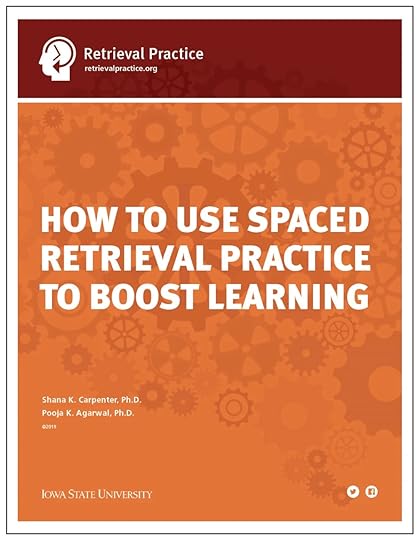 Download our free Spacing Guide Dr. Carpenter's Tips on YouTube Learn about Dr. Shana Carpenter
Download our free Spacing Guide Dr. Carpenter's Tips on YouTube Learn about Dr. Shana Carpenter 
Dr. Shana Carpenter (she/her) is a Professor of Psychology at Oregon State University near Portland, Oregon. She specializes in research on cognitive science principles that can be applied in classrooms to help students retain information, transfer what they have learned to new situations, and improve their awareness of their own learning.
Dr. Carpenter is the world’s leading expert on spacing (also known as “spaced repetition”), with recent research on the use of pre-questions for retrieval practice. If you’re familiar with tech tools for students that use spacing, like Anki and Quizlet (plus hundreds of videos on YouTube about using spaced repetition as a study strategy), these flashcard algorithms and study tips are all based directly on Dr. Carpenter’s research.
She is the author of over 70 published journal articles and book chapters, and her work has been featured in The Washington Post, Forbes, The Chronicle of Higher Education, and Edutopia. She earned her Ph.D. from Colorado State University, followed by a post-doctoral fellowship at the University of California, San Diego, and a professorship at Iowa State University.
Dr. Carpenter is also a teacher. She teaches undergraduate courses and advanced seminars on cognitive psychology, memory, and research methods. She gives talks and interviews on the science of learning, both in the U.S. and internationally, and facilitates professional development workshops at schools, universities, and organizations. Click here for Dr. Carpenter’s contact info and reach out to her for more information about her speaking, her research—and of course, her teaching.
Recommended publications by Dr. Carpenter:
Carpenter, S. K., King-Shepard, Q., & Nokes-Malach, T. (2023). The prequestion effect: Why it is useful to ask students questions before they learn, published in In Their Own Words (download the e-book and click here for a detailed literature review about prequestions)
Carpenter, S. K., Pan, S. C., & Butler, A. C. (2022). The science of effective learning with spacing and retrieval practice. Nature Reviews Psychology, 1(9), 496-511. This publication by Dr. Carpenter was selected as one of the 10 Most Significant Education Studies in 2022 by Edutopia.
Carpenter, S. K., Cepeda, N. J., Rohrer, D., Kang, S. H., & Pashler, H. (2012). Using spacing to enhance diverse forms of learning: Review of recent research and implications for instruction. Educational Psychology Review, 24(3), 369-378.
Read Dr. Carpenter's ResearchAugust 13, 2025
Here are my favorite back-to-school activities to strengthen learning
Welcome back to school! For most of us (myself included), the whirlwind of lesson prep, meetings, professional development—and of course, teaching—is here. Keep reading for my favorite back-to-school activities to engage students with retrieval practice during the first week of class.
Reminder: Click here to register for our Science of Learning workshop. It’s on Zoom TOMORROW, August 14 from 1–4pm ET. Group discount: Register 5 or more people and use promo code SAVE15 for 15% off the total.
P.S. The Zoom workshop will not be recorded. Can’t attend? Read our new book, Smart Teaching Stronger Learning, and click here to download a free list of tips. Interested in hosting a workshop at your school? Email me at ask@retrievalpractice.org for details.
Register for the workshop Join us on Zoom tomorrow!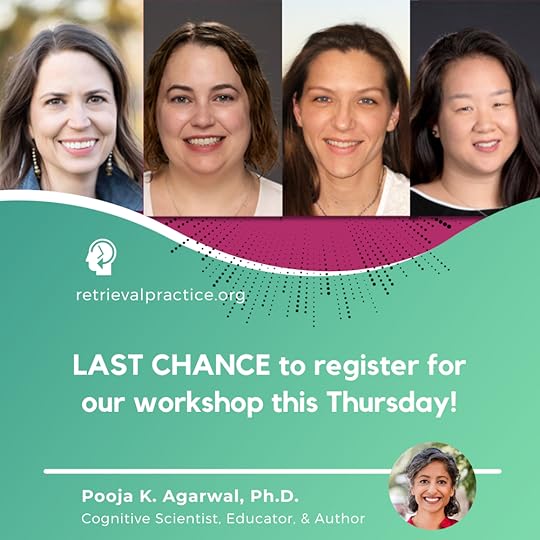
Last chance to register for our interactive online workshop TOMORROW, Thursday, August 14 via Zoom from 1–4pm ET,
We’re bringing together 5 cognitive scientists and 50+ educators from around the world for back-to-school teaching tips. Because the workshop is discussion-based in breakout rooms, the Zoom will not be recorded.
We have a sliding scale for registration and get 15% off for groups of 5 or more registrants (promo code SAVE15).
Register for the workshop Use retrieval practice the first week of class
I love the first day of class. The buzz, the nervousness, the fingers-crossed-it’ll-go-well feeling—I seriously love all of it!
It may (or may not) surprise you to know that my first day of class is full of retrieval practice. Even if you haven’t introduced content yet, use retrieval practice the first day or week of class. Here’s how, with quick activities you can adapt for K–12 students, higher ed courses, and all content areas:
Get students familiar with retrieval practice from day 1 with no-stakes trivia questions and warm up questions where everyone knows the answer (click here to download my free warm up slides)
Build a welcoming class culture with (spoiler alert: trying to memorize names with students’ LMS photos doesn’t work)
Jumpstart students’ prior knowledge with an engaging ungraded pre/post worksheet (check out an example of my worksheet online)
Boost students’ long-term learning from previous classes with a brain dump or two things activity in one minute or less
Make students’ break memorable with a simple question to model how we retrieve in everyday life
Don’t waste the valuable opportunity you have at the beginning of the school year to go over the syllabus and let students out early (I recently heard this referred to as a “silly-bus-day”). Ice breakers serve a purpose, but they can also get stale. For more tips, I highly recommend anything and everything by James Lang, including his book Small Teaching and his advice guide to a good first day of class. If you haven’t already, click here to watch a recording of our recent conversation about teaching and learning.
Key take away: Use the first week of class to pique students’ curiosity, support sharing without feeling put on the spot, and prepared to learn with the simplest and most robust research-backed learning strategy: retrieval practice.
August 3, 2025
Register for our first-ever workshop on Thursday, August 14, 2025

Ready to strengthen your students' long-term learning this school year? Gain practical tips from cognitive scientists who are also teachers!
On Thursday, August 14, 2025 from 1–4pm ET, join us online for an interactive 3-hour workshop. In this first-ever live event, five renowned learning experts share innovative teaching strategies they use in their own classrooms.
Click here to register for our Zoom workshop. We also have an early bird rate! Register by August 8 for $10 off, and help us spread the word on social media by tagging @RetrieveLearn for an extra $3 off. We’re teachers and we love discounts, too. 😝
P.S. Can’t attend the workshop? FOMO is real and you don’t have to miss out. Read our new book, Smart Teaching Stronger Learning, and click here to download free resources.
Register for the workshop We practice what we preach!
With our interactive online workshop on August 14, 2025 from 1–4pm ET, enrich your pedagogy and professional growth with down-to-earth tips straight from the source: learning researchers who are also classroom teachers. Learn how you already use evidence-based methods—such as retrieval practice, interleaving, and metacognition—and gain creative strategies to strengthen student motivation, long-term learning, and success.
Approximately 1.5 hours of the workshop will be flash talks and tips from the speakers, and 1.5 hours of the workshop will be spent in small breakout groups applying what you’ve learned. Because the workshop is live and synchronous, the Zoom will not be recorded. Like a flipped classroom, attendees are expected—but not required—to learn about the science of learning in advance, and fully participate in breakout discussion to share and learn with our community.
Geared toward educators in K–12 and higher ed, our workshop will be informal, in-depth, and memorable. To get a sense of the vibe, watch our book launch video on YouTube, and here’s a preview of what to expect:
Get tips from Dr. Janell Blunt on how you can use white boards for engaging retrieval practice
Get tips from Dr. Shana Carpenter on how you can apply spacing in your lessons without starting from scratch (download her free guide on spacing)
Get tips from Dr. Lisa Fazio on how you can foster metacognition to boost long-term learning (download her free guide on early childhood education)
Get tips from Dr. Veronica Yan on how you can use interleaving by simply mixing up concepts
Equitable access is important to us. That’s why we have a sliding scale for registration:
Early Bird Rate: $79 (register by August 8)
Standard Ticket: $89
Sponsor an Educator: $129
Community Access Ticket: $49
Want an additional discount? Post a photo on social media with our new book, Smart Teaching Stronger Learning, and tag @RetrieveLearn. You’ll receive a DM with a promo code for $3 off the registration price. Selfies encouraged! Visit retrievalpractice.org/smart-teaching for more information and free downloads from our book.
My colleagues and I lead customized professional development at schools and universities around the world (email ask@retrievalpractice.org to request an event). Here’s what educators are saying about our workshops:
“Excellent information, with easy to do things that can make a huge difference right away!”
“Word around the college has been positive and faculty have shared some epiphanies they had about their instruction after the workshop.”
“There was retrieval practice happening all over the place after the workshop!”
“We continue to see these strategies being used throughout our campus. Thanks for helping us all learn and grow.”
Register for the workshop Tag @RetrieveLearn for $3 off Featured Workshop Speakers Teaching Tips From the Speakers Download tips from our bookJuly 2, 2025
Like a tie-dyed shirt: Mix it up with interleaving and boost learning
This week, I’m thrilled to share the research, teaching tips, and insights from cognitive scientist and educator, Dr. Veronica Yan, one of the world’s leading experts on interleaving.
What’s interleaving? It’s a teaching and studying strategy to challenge and improve learning by mixing things up: problem sets, flashcards, vocabulary words, different types of storytelling structures, etc.
It might sound complicated, but like all the research-based strategies I share: interleaving doesn’t require extra prep, class time, or grading. It’s a small adjustment that makes a big difference for student learning inside and outside the classroom.
Learn how to implement interleaving with teaching tips from Dr. Yan below, adapted from our new book, Smart Teaching Stronger Learning.
Learn more about our bookP.S. Scroll below for free resources from the book. And save the date! We’ve got an exciting event coming up on Thursday, August 14… 🤓
Like a tie-dyed shirt: Mix it up
As Dr. Yan explains in Smart Teaching Stronger Learning:
“The world comes at us interleaved. Prior to starting school, we typically encounter things mixed up, but once we enter school, things start to look different. We want students to develop conceptual understanding and skills that they can use in other parts of their lives, both in and out of the classroom. To really instill these skills with our learners, should they focus on just one thing at a time, or should they go back and forth between different concepts or skills?”
For example, students might traditionally study concepts in a biology course one at a time: prokaryotic cells, eukaryotic cells, cell membranes, diffusion, osmosis, and active transport. But concepts and skills on exams and in real life are like a tie-dyed t-shirt: all mixed up.
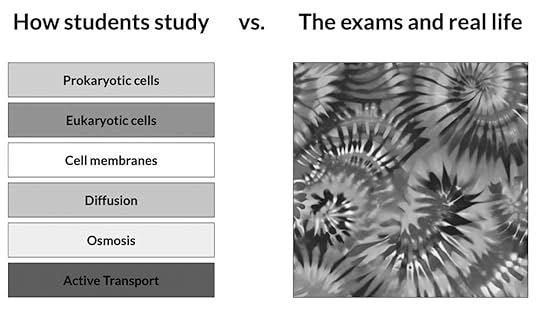
Interleaving facilitates learning how to distinguish between related and confusable concepts. And going back and forth between concepts helps to build deeper conceptual understanding.
Here are a few practical tips from Dr. Yan’s chapter:
Interleave and mix up existing homework or practice questions. Shuffle current and previous problems, not just what students are learning right now.
Draw explicit attention to contrasts and comparisons by using spaced retrieval practice by calling back to previously taught concepts. For example, “What have we already covered that this idea reminds you of?” and “What’s the difference between concept A and concept B?”
Keep it fresh: Frame interleaving as a positive and more interesting challenge to go back and forth between different types of questions, rather than doing the same thing over and over again.
Explain the purpose of interleaved practice to your students. Interleaving reveals to students the possible confusions they might have and it gives them the type of practice that better matches final exams and real life.
Download tips from our book Learn about Dr. Veronica Yan
Dr. Veronica X. Yan (she/her) is an Associate Professor and Director of the Science of Learning and Memory Lab at The University of Texas at Austin.
Dr. Yan's research bridges social, cognitive, and educational psychology fields to explore how we can empower people to become motivated and effective self-regulated learners. She earned her Ph.D. from the University of California, Los Angeles.
Dr. Yan is also a teacher! She teaches a learning and motivation course to pre-service teachers, and graduate courses on cognitive psychology, interleaving, and metacognition. Her own educational experience has spanned multiple countries, including primary and secondary school in Hong Kong, undergraduate education in England, and graduate school in the United States.
Dr. Yan is a consultant with the Texas Education Agency, and she leads professional development workshops around the world that integrate research findings with practical teaching strategies. She was recently featured on the Learning Science Podcast by Voovo. Follow Dr. Yan on Bluesky and LinkedIn, and check out her research on Google Scholar.
Dr. Yan’s recent publications:
Yan, V. X., Arndt, A., Muenks, K., & Henderson, M.D. (2024). I forgot that you existed: Role of memory accessibility in gender citation bias. American Psychologist, 80, 91–105. (Click here to learn more about citation gender bias and how you can help!)
Yan, V. X. & Sana, F. (2021a). Does the interleaving effect extend to unrelated concepts? Learners’ beliefs versus empirical evidence. Journal of Educational Psychology, 113, 125-137.
Yan, V. X. & Sana, F. (2021b). The robustness of the interleaving effect. Journal of Applied Research in Memory and Cognition, 10, 589-602.
Follow Dr. Yan on Bluesky Read Dr. Yan's Research Course adoption and book studies!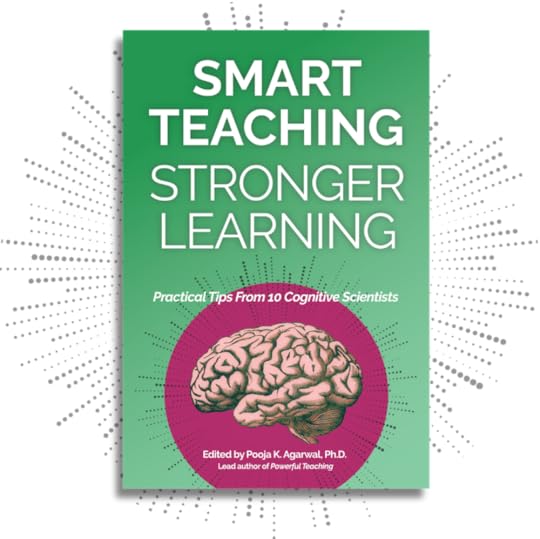
Written for K–12, higher ed, and beyond, Smart Teaching Stronger Learning is a practical and short book, written by cognitive scientists who are also teachers. If you’re looking for a beach read, we promise this one’s a breeze! 🏖️ As a teacher from Chicago shared with us, “Love the book so far! Very good simple strategies that don't seem difficult to implement!”
We are thrilled to share that teachers are adopting our book for undergrad and graduate courses, book groups, teaching centers, and professional development.
If you are interested in a bulk order discount for your school, email me at ask@retrievalpractice.org for more information.
If you want to create a semester-long course or a book study, each chapter includes two carefully selected additional readings (click here to download the list of articles). 10 chapters (only 10 pages each) + 2 journal articles per chapter = a semester-long course.
If you are developing discussion questions, slides, and/or resources for your course or book study, please let me know. The best resources come from our readers and I would love to share your creations.
The authors are here to support you! Located around the world, they are actively speaking at conferences and schools, sharing their knowledge with educators on Zoom, and forming research collaborations. Get in touch with the authors via our website (scroll down to author information, or email me if you’d like help), which includes links to their social media and contact info. Don’t be shy; they’d love to hear from you.
Here’s an example of a course adoption: In one of contributing author Dr. Michelle Rivers’s college courses, students simply read a book chapter and shared a summary of what they learned. From Dr. Rivers: “It generated great discussion! Students loved the idea of concept mapping and many of them are going to try it in their own learning. We also talked about how some of the strategies will only work if they come from an understanding professor (e.g., sharing times when we have also failed during the learning process) — that the affective/motivational aspects of learning are very important, too.”
Don’t have time to read our book or not ready to purchase it? I totally get it. It’s been a long school year and I love free resources. Download our “cheat sheet” of one teaching tip per chapter and read the full book introduction online. You can also watch this Zoom recording of our book launch with the authors!
Want to read even more on the science of learning and use them in your courses? Check out my full list of recommended books and my summer reading challenge from a few years ago.
Watch the book launch on YouTubeApril 30, 2025
Make bite-sized adjustments to what you’re already doing
My colleague and friend (who’s also a cognitive scientist and educator), Dr. Michelle Rivers, has some simple, bite-sized strategies to use what you’re already doing in the classroom and boost student learning even more.
Dr. Rivers’s strategies take little or no prep, no extra grading, and very little time to implement. Keep reading to find out how to:
Turn your learning objectives into “questions du jour”
Replace name tags with name tents
Invite students to rate their confidence before, during, and after retrieval practice
Encourage students to explain their answers
Plus, listen to this brand new Cult of Pedagogy podcast episode with Dr. Rivers (and figure skating!), which also features Dr. Janell Blunt and her tips on how to use whiteboards for retrieval practice.
Listen at Cult of Pedagogy Research by Dr. RiversP.S. Join our free informal Zoom Party tomorrow, May 1 at 5:00pm ET! Learn how to teach, how to write like you teach, and how to remember names. Register at retrievalpractice.org/party.
Small changes make a big difference
As Dr. Michelle Rivers explains in our new book, Smart Teaching Stronger Learning, you can small but powerful adjustments that increase engagement, deepen understanding, and foster sustainable improvements without a complete overhaul of your teaching. Here are a few strategies from Dr. Rivers’s chapter:
Have students answer “questions du jour” before a lesson (questions of the day). Instead of giving them learning objectives, present learning objectives as questions to encourage retrieval practice and activate prior knowledge. Recent research by Dr. Shana Carpenter on “pretrieval” (get it?) and Dr. Faria Sana on learning objectives demonstrate that pre-questions improve learning.
Use name tents (folded cardstock) with a retrieval practice question on the inside. Instead of using name tags to learn students’ names and to help take attendance, use name tents as a brief exit ticket to check for understanding, gather feedback, and encourage reflection. Sample name tent questions include: “What is one thing you learned today?,” “What was the most challenging part of today’s lesson?,” and “How would you use what you learned today outside of class?”
Have students rate their confidence before, during, and after retrieval practice to improve their metacognition. For example, you could say, “How confident are you that your response is correct? Hold up one finger if you’re not confident (just guessing) and five fingers if you’re very confident.” This quick self-assessment allows students to recognize when they may need more practice or review.
Invite (or require) students to explain their answers to questions. Instead of just assessing learning with multiple-choice questions, use self-explanations to help students think more deeply and connect what they’re learning to other concepts. Also, when students are torn between two answers, explaining their choice can often help them make a decision. For more information about this strategy, read this blog post about elaboration by Dr. Megan Sumeracki and the Learning Scientists.
Download more free tips Learn about Dr. Michelle Rivers
Dr. Michelle Rivers (she/they) is an Assistant Professor at Santa Clara University near San Jose, California. They teach courses on cognitive psychology and research methods. Dr. Rivers has also taught hands-on science and engineering topics to K–12 students, tutored high school students, and taught undergraduate and graduate courses focused on research methods and cognitive science.
Dr. Rivers’ research applies theories of learning and memory to enhance educational practice. They are particularly interested in investigating factors that contribute to students’ metacognitive judgments. Their work has been published in leading peer-reviewed academic journals, and recognized by the National Science Foundation, the American Psychological Association, and the Psychonomic Society.
Dr. Rivers is passionate about science communication and mentoring LGBTQ+ students interested in STEM fields. They founded the blog Cogbites (bite-sized cognition, cogbites.org), where early-career scientists work together to translate research about the study of mental processes for the general public. Dr. Rivers earned their Ph.D. from Kent State University.
Dr. Rivers’s recent publications (with links to PDFs):
Rivers, M. L., Babineau, A. L., Neely, K. P. & Tauber, S. K. (2025). How do students and faculty consider numerical ratings and comments about daily quizzing when interpreting student evaluations of teaching? Teaching of Psychology, 52(1), 86-97.
Rivers, M. L. (2023). Test experience, direct instruction, and their combination promote accurate beliefs about the testing effect. Journal of Intelligence, 11(7), 147.
Rivers, M. L. (2021). Metacognition about practice testing: A review of learners’ beliefs, monitoring, and control of test-enhanced learning. Educational Psychology Review, 33, 823-862.
Rivers, M. L., Dunlosky, J., & Persky, A. M. (2020). Measuring metacognitive knowledge, monitoring, and control in the pharmacy classroom and experiential settings. American Journal of Pharmaceutical Education, 85(4), 549–560.
Follow Dr. Rivers on LinkedIn Read Dr. Rivers's BlogApril 23, 2025
Two red flags to watch out for at conferences
Conferences are a great place to learn and feel energized. But to be honest, sometimes I leave feeling frustrating. In my experience, most of the information presented is legit, but some of it is just pure nonsense.
There are two red flags I always watch out for at conferences, and you should, too:
Outdated citations for classroom research that wasn’t actually conducted in classrooms
Neuromyths, misleading information, and irrelevant pictures of the brain
I’ve attended at least 50 conferences throughout my career as a scientist and educator, and these two red flags make me cringe. Every. Single. Time. Keep reading to find out why you should replace cringeworthy citations with my list of recent research, as well as tips on how to spot neuromyths from cognitive scientist Dr. Roberta Ekuni.
Make sure to register for our Zoom Party on May 1, 2025 at 5pm ET with higher education powerhouses James Lang and Michelle Miller. Join us for an informal conversation about teaching, writing, and how to remember names.
Also, I’ll be at the Learning & the Brain Conference this weekend (my keynote is on Sunday, April 27 in the morning). Keep your eyes peeled for the two red flags and let me know if you spot them!
Update your citations Learn about neuromythsTL;DR: If I'm talking about learning in the lab, my citations are (usually but not always) pre-2010. If I'm talking about learning in the classroom, my citations are (most likely) post-2010.
Join our Zoom Party with James Lang and Michelle Miller on May 1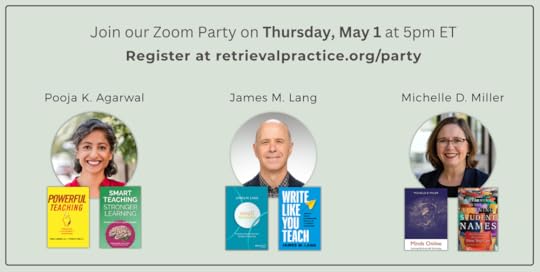 Register for the Zoom Party
Register for the Zoom Party On Thursday, May 1 at 5:00pm ET, I’ll be hosting a Zoom Party with Dr. James Lang, author of Small Teaching and Write Like You Teach, and Dr. Michelle Miller, author of Minds Online and A Teacher's Guide to Learning Student Names. Join the informal conversation and walk away with practical tips to improve your teaching, writing, and memory.
Visit retrievalpractice.org/party to register. The Zoom Party will be recorded, but you must register to access the recording.
If you’ve ever thought about writing an op-ed or book — to share your area of expertise, how you teach, or awkward classroom moments — Jim’s practical tips on how to get started are pure gold. I truly wish I had his new book, Write Like You Teach, when I first started out as an author. And if you’ve ever struggled with student names, Michelle has a wealth of advice for improving your memory.
Thank you to the 50+ educators who attended our live book launch Zoom Party for Smart Teaching Stronger Learning! We had a blast learning about the authors, sharing teaching tips and free resources, and reminiscing about our 20+ years of friendship.
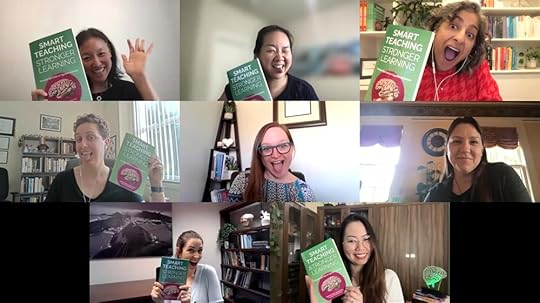 Conference Red Flag #1: Outdated Citations
Conference Red Flag #1: Outdated Citations 
If you attend a conference, keynote, or workshop on the science of learning, pay attention to the citations included on speakers’ slides. Here’s a rule of thumb: Is the citation before or after 2010?
Why are outdated citations (pre-2010) my biggest pet peeve at conferences? Because we’ve learned a lot about learning in the past 15 years. Most real-world retrieval practice research conducted in authentic classrooms was published after 2010.
How can you (or a speaker) update citations? I’ve made it easy by curating two lists of recent references: Here’s a list of 10 articles on the science of learning, and here’s another list of 20 articles from my book Smart Teaching Stronger Learning. Both lists are organized by topic area (retrieval, spacing, interleaving, etc.) and I’ve included open access links to each article (when available). All 30 articles were published after 2010.
If you see a citation for cognitive psychology research from before 2010, chances are high that it was conducted in a laboratory using individual cubicles and computer stations (this is also before iPhones and Instagram became popular, for context).

Carefully controlled laboratory research is essential in understanding the fundamentals of human behavior, learning, and memory, and this type of research continues today (particularly with large sample sizes from online experiments). If a speaker is talking about theoretical or foundational lab research on learning, then pre-2010 citations work well.
Applied research in the real world, even if it’s “messy,” is also essential in understanding how learning works. If a speaker is talking about learning in the classroom, then post-2010 citations are more appropriate. (Here’s an awesome example with updated citations from Matt Miller’s Ditch That Textbook blog.)
Citations on the science of learning need to reflect the critical shift from laboratory research to classroom research that occurred around 2010. It’s been 15 years! We can do better. And if a conference speaker is using post-2010 citations when talking about learning in the real world, it’s reassuring to know that they’re keeping up with current research.
View a list of updated citations View 20 more articles Conference Red Flag #2: Neuromyths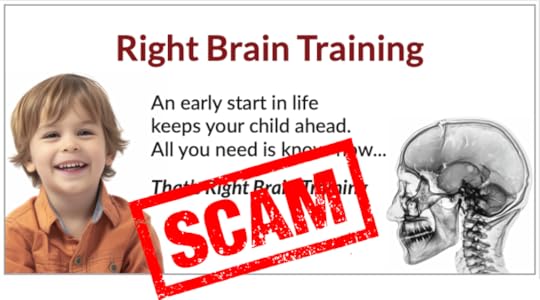
As Dr. Roberta Ekuni explains in her book chapter in Smart Teaching Stronger Learning, myths about how the brain works are everywhere, especially in education. Plus, claims that include the words “neuro” or “brain” take advantage of our fascination with brain-related information (known as the seductive allure effect). If I could count the number of times I’ve encountered neuromyths at education conferences, I would have as many fingers as AI-generated humans (times a thousand).
How familiar are you with neuromyths? Take my neuromyths quiz and find out.
There’s nothing wrong with being curious about the brain, but it is important to be aware of neuromyths, learn how to spot them, and engage in mythbusting with educators and students. Classroom time and resources are valuable. They should be allocated to evidence-based teaching and studying strategies that consistently improve learning, not spent on methods or products based on neuromyths. In Dr. Ekuni’s research, more than 30% of teachers reported basing their decisions on inaccurate information about the brain.
Here are some tips from Dr. Ekuni to help you identify what is a legit claim based on neuroscience research vs. a misleading neuromyth:
Stay alert: Pay attention to books and products that include terms like “neuro” or “brain.” Think about whether they are taking advantage of the seductive allure effect. Even fake pictures of brains are persuasive.
Be skeptical of perceived authority: Just because a so-called authority figure said something about the brain doesn’t make the statement (or the person’s expertise) valid or accurate.
Ask for details: Don't trust claims about a product where “a study shows” it works. Instead, ask, “What study?” before investing your time or money.
Disseminate accurate information: Use your social networks to share accurate scientific information about the brain (check out my interview with Mythbusters on YouTube). Avoid sharing information that you are not sure is true.
Discuss with your colleagues and students: Share evidence-based teaching strategies (like retrieval practice!), complete a neuromyths quiz (click here to download a worksheet version), and rally around a collective goal: using critical thinking when making educational decisions.
Take the neuromyths quiz Learn about Dr. Roberta Ekuni
Dr. Roberta Ekuni (she/her) is an Adjunct Professor at Universidade Estadual de Londrina in Paraná, Brazil. She specializes in research on retrieval practice, neuromyths, and cross-cultural learning. She earned her Ph.D. from the Universidade Federal de São Paulo.
She teaches courses on neuroscience and research methods. Her popular videos, podcasts, and articles reach thousands of students and teachers around the world (she has more than 30,000 followers on Instagram @DraRobertaEkuni). Dr. Ekuni also led efforts to translate my practice guides in Portuguese, and she created a YouTube video about retrieval practice in Portuguese.
Dr. Ekuni and I have a few publications together about “WEIRD” research. The acronym WEIRD, in the context of research, refers to experiments conducted with participants from Western, Educated, Industrialized, Rich, Democratic countries. In this article from 2010, scientists found that more than 80% of participants in psychology research are from WEIRD countries, but they represent only 12% of the world’s population. This is also something to keep an eye out for at conferences: Where was the research conducted?
I am inspired by Dr. Ekuni’s efforts to conduct research and share the science of learning in Brazil, and I am grateful for her contributions on neuromyths in Smart Teaching Stronger Learning.
Dr. Ekuni’s recent publications:
Where did pre-service teachers, teachers, and the general public learn neuromyths? [Download PDF]
Neurophilia is stronger for educators than students in Brazil [Download PDF]
Are study strategies universal? A call for more research with diverse non-WEIRD students [Download PDF]
A conceptual replication of survey research on study strategies in a diverse, non-WEIRD student population [Download PDF]
Learn about neuromyths in educationApril 15, 2025
Use white boards for flexible retrieval practice
If you’ve gotten your hands on my book, Smart Teaching Stronger Learning, you probably noticed two things: It’s practical and it’s short. Applicable for K–12 and higher ed, it has 10 chapters that are only 10 pages each.
(Because let’s be honest, we don’t always have time to read books.)
Each chapter features a cognitive scientist who’s also a teacher. These teacher-scientists practice what they preach, and they use their own research to guide their instruction. In my newsletter, I’ll be featuring a cognitive scientist from the book and their practical research-based activities you can use in your classroom to strengthen learning.
Learn about teacher-scientist Dr. Janell Blunt and her tips on how to use white boards for flexible retrieval practice. We also held a book launch Zoom Party, featuring Dr. Blunt. Did you miss it? Click here to subscribe for my newsletter for announcements and upcoming events.
P.S. If you bought the book on Amazon, please take a moment to post a rating or review. Even better: help educators with a quote or photo of your favorite strategy in your review!
P.P.S. Sending a very big thank you to Matt Miller at Ditch That Textbook for sharing our book in his newsletter! His blog is geared toward K–12, but as a college professor, I have learned a ton from his resources. Subscribe for his newsletter here.
Buy the book More information White boards: Flexible, fun, and effective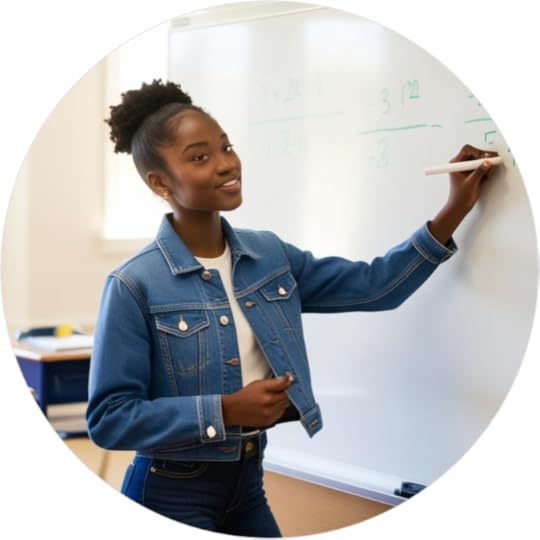
As Dr. Janell Blunt describes in her book chapter in Smart Teaching Stronger Learning, she has an old suitcase full of small white boards and dry erase markers that she brings to her introductory psychology class every day. Students know to grab a white board before heading to their desks.
Why white boards? Because they provide flexibility for the types of question prompts you can ask. Plus, white boards give students the opportunity to retrieve what they’ve learned in different formats: images, words, tables, phrases, etc.
Rather than starting class by reviewing a previous lesson, simply ask students to retrieve information by writing answers on their white boards. These questions can be ones you’ve made in advance or ones you think of on the spot if you notice students struggling to understand a concept or stay focused. You can also have students share their responses with peers and help each other out — much like team building exercises, but without a competitive environment.
Some example question prompts:
Brain dump and retrieve as much as you can in 2 minutes
Retrieve and write down two things or three key concepts from class
Write down a new example of a topic you’re learning about and share examples with peers
Write down something about today’s lesson that was challenging
Draw an image that describes concepts from yesterday’s lesson
Additional tips:
Don’t use paper. Students enjoy the novelty of white boards, and having an eraser on hand normalizes mistakes and eases student anxiety. Mistakes are okay — just erase it and retrieve again.
Start early: For best results, introduce white boards on the first day of class
Emphasize the importance of not using notes while retrieving. Remind students that difficult learning is learning that lasts.
Insert a slide with a photo of a golden retriever in your lecture as a cue to have students retrieve every 10 minutes to break up lessons
For a low-cost alternative to purchasing white boards, create your own by putting blank pages of paper into sheet protectors with cardstock, and create erasers with scrap pieces of fleece fabric.
Dr. Blunt’s students really enjoy white boards. They like them so much that her white boards have become “contagious.” Students in other classes have created their own white boards as a study tool and they ask their instructors to use them during class. With Dr. Blunt’s simple strategy (backed by her own research and teaching experience), you can foster a classroom with engaged students who are eager to retrieve, learn, and support each other.
Download tips from the book Learn about Dr. Janell Blunt
Dr. Janell Blunt (she/her) is an Associate Professor at Anderson University, near Indianapolis, Indiana. She specializes in research on concept mapping and retrieval practice, including guided retrieval practice for elementary school students. She earned her Ph.D. from Purdue University.
Dr. Blunt’s research focuses on answering questions such as: How do students learn? What study strategies promote lasting, meaningful learning? How can evidence-based strategies, like retrieval practice, be incorporated into classroom activities?
Her work is published in several top academic journals, including the prestigious journal Science, as well as The New York Times and the ScienceDaily News.
Dr. Blunt teaches courses on cognitive psychology, research methods, and statistics, and leads learning workshops for students and faculty. She also created a course on LinkedIn, Strategies to Learn and Upskill More Effectively, where she shares evidence-based strategies for learning at school, work, or play. Dr. Blunt is passionate about bridging the gap between research and practice, and helping learners of all ages achieve their goals.
Follow Dr. Blunt on LinkedIn Watch Dr. Blunt's Video on YouTubeApril 8, 2025
NEW book: Smart Teaching Stronger Learning
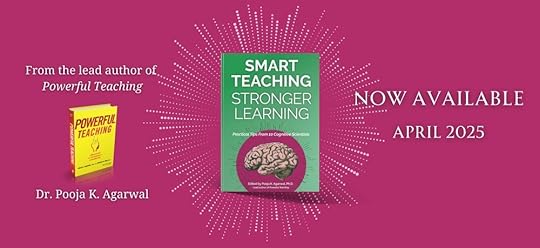
I am thrilled to announce the publication of my new book, Smart Teaching Stronger Learning: Practical Tips From 10 Cognitive Scientists.
What I love about it: It’s short, practical, and full of ideas to make teaching memorable.
Why the book exists: To bring together a team of cognitive scientists, who are all teachers(!), to share a variety of tips from their own classrooms.
Why I hope you’ll read it: It isn’t science-y at all. No jargon, no statistics. Just teachers talking about teaching, with legit evidence-based classroom strategies straight from the (scientific) source.
Plus…
We’ll be donating $1 for every book purchased on launch day (April 8) by 11:59pm ET to a non-profit, FriendshipWorks. Help make a difference in the lives of elders!
We’re hosting a book launch party via Zoom on Tuesday, April 15 at 5:00pm ET. Click here to register.
I want to thank you, my newsletter readers, for continuing to give me energy and encouragement to keep going on this path of improving education. I truly can’t do it without you and I am grateful for your support.


 Smart Teaching Stronger Learning
Smart Teaching Stronger Learning 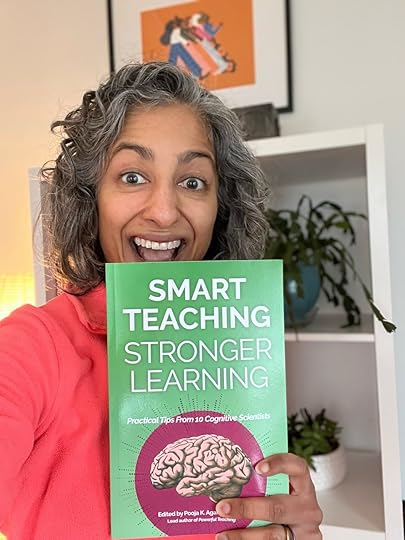
Smart Teaching Stronger Learning is (I hope) going to move the needle on improving teaching, learning, and education. And with unique classroom perspectives from 10 experts on learning, this is the kind of book I wish I had when I started teaching.
Written for K–12 and college/university teachers and administrators, this book is short. Seriously short: 10 chapters, only 10 pages each. We know what it’s like to be busy: juggling lesson plans, emails, and meetings — and of course, the actual teaching.
Luckily, the contributors have done the heavy lifting for you by translating research, developing class activities, and testing them out in their own classrooms. They’re representative of today’s educators and they know what it’s like to teach in the real world.
Click here to read an excerpt from the introduction, view the table of contents, and learn more about the authors. Topics include retrieval practice, spacing, and interleaving, with more tips on how to motivate students, support their transfer of learning, and combat neuromyths.
We’ll be donating $1 for every book purchased on launch day (April 8, 2025) by 11:59pm ET to a non-profit, FriendshipWorks. Located in Boston, their mission is to end social isolation for older adults. On a near weekly basis, my elder buddy Peter and I get together, and I feel so fortunate to spend time with him. I hope you’ll join me in this fundraising effort.

Smart Teaching Stronger Learning is available in paperback and Kindle/e-book from major retailers, including Amazon, Bookshop, and Barnes & Noble. Please support your local independent bookstore by making purchase through Bookshop.org (it’s currently cheaper than Amazon!).
Whether you teach K–12 students or graduate students, or you’re new to teaching or a long-time educator: If you want to improve student learning, this book is for you.
Read an excerpt Meet the authors at our Zoom party on April 15, 2025
The 10 cognitive scientists featured in Smart Teaching Stronger Learning are amazing teachers, researchers, and human beings. We’re a close-knit community of friends (the stories I could tell…) and I feel so fortunate that they’ve all gone along with my zany idea to put together this book.
Meet the authors at our book launch via Zoom on Tuesday, April 15 from 5-6pm ET (eastern time zone). Join the informal conversation and walk away with some teaching tips you can implement immediately.
Click here to register for our Zoom Party. It will be recorded, but you must register to access the recording. I look forward to seeing you there!
Register for the Zoom Party


